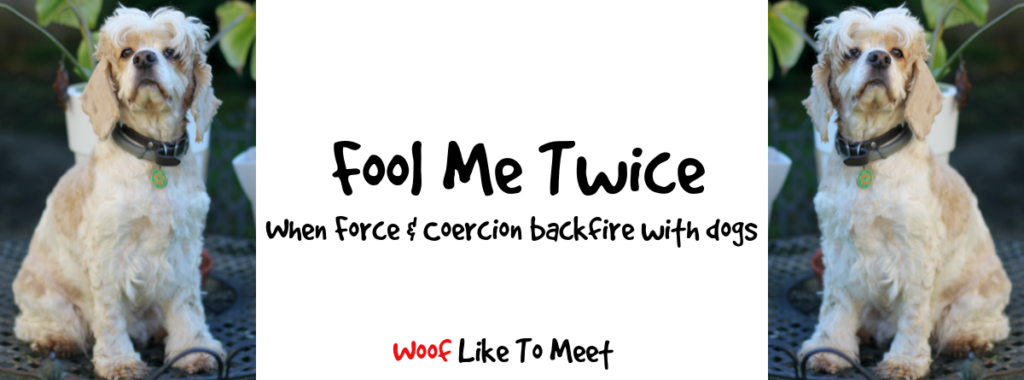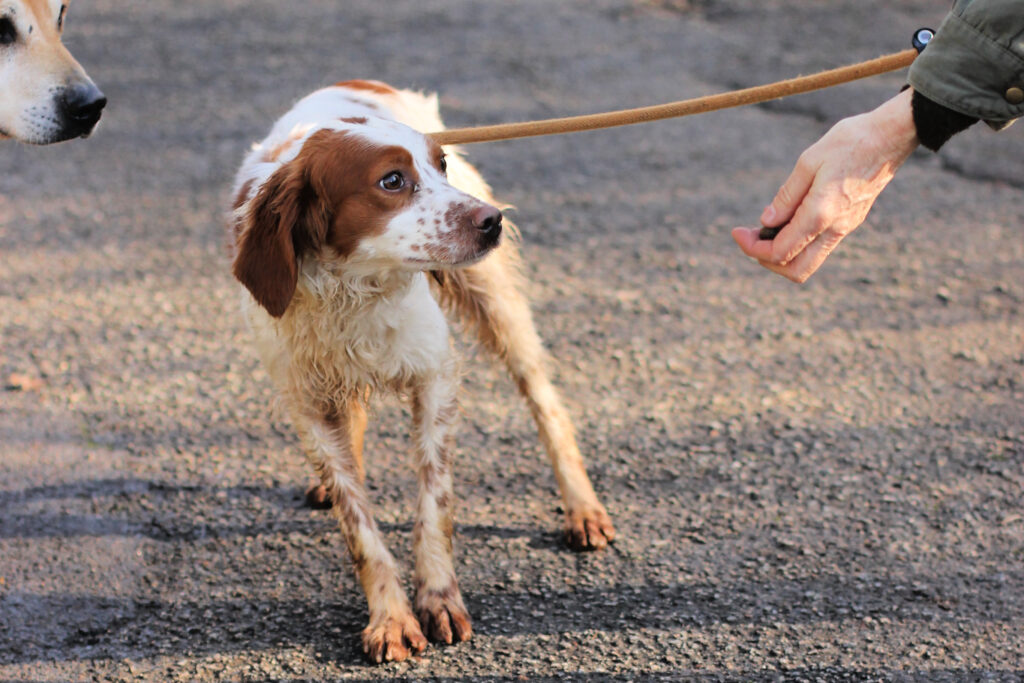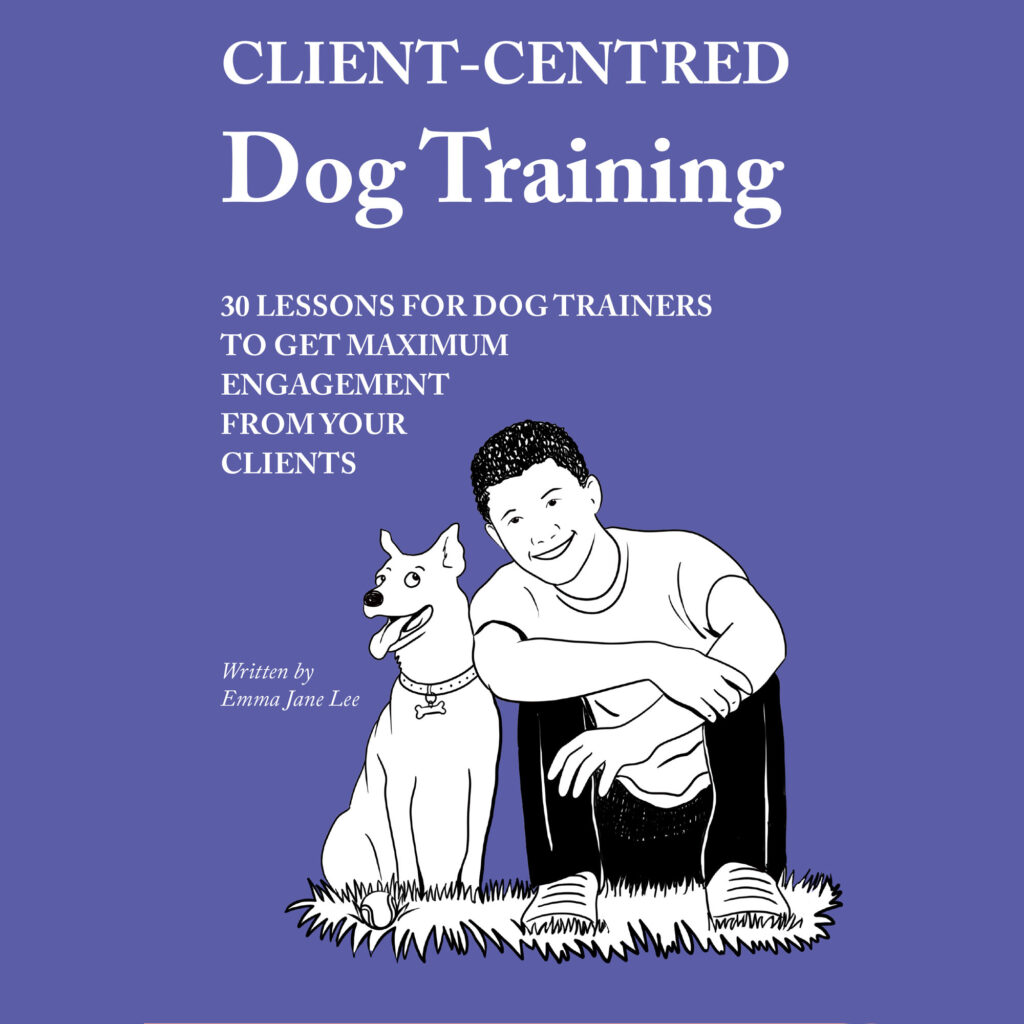You know the old saying: ‘Fool me once, shame on me. Fool me twice, shame on you.’
That expression is so very true of dogs.
It can seem like such a simple solution to our problems. Just do it. Get it over with. Whatever it is won’t be that bad that the dog will take an instant dislike to it. Vet visits, medical treatment, trips in cars, being on their own, tolerating absence, going to daycare, visits to the dog park with scary-looking dogs, trips to the market, going for a walk, visits to cafés, nail clipping, muzzle use… even wearing a harness. All of these activities are the kind of things where humans can be tempted to think, ‘oh let’s just get it over with!’
To be fair, there are times when needs must. I lived with cats before having dogs as an adult. The first time I realised I needed to use a cat transport cage was the time my cat had an abscess that needed urgent treatment. I did not have time to make the whole experience more pleasant. In fact, since he’d arrived with me in a crate, you can be pretty sure he still remembered that horrible experience.
When you’re a cat guardian, I think you realise more easily that you can’t fool cats twice. Thinking of disguising a pill in paté? Good luck! It may work a little the first time, but I’d put money on it not working the second.
So when things are true emergencies, when we really don’t have the benefit of time, we might resort to force – whatever the situation is.
As long as it’s a one-off occasion, we won’t have to worry about the repercussions.
The trouble is that most things are not a one-off. Especially things that the animal finds traumatic.
So why can that one-off single traumatic event be so powerful?
Single-event fear learning is well-known in the psychology world. Where we truly fear for our safety or our lives, then our brain is very good at finding ways to make us avoid that situation in the future. After all, many millions of years of mammalian evolution mean that our ancestors – dog or man – were the ones who did learn from traumatic experiences. Avoiding or trying to escape from potentially life-threatening situations is advantageous from an evolutionary perspective.
Now you know and I know that wearing a harness is not a life-threatening situation. It doesn’t hurt, for goodness sake. We may even have gone out of our way to buy a harness made of fleece and loveliness.
Sticking a muzzle on a dog isn’t going to kill them.
Taking them for a walk in the park is not a life-or-death thing, on the whole.
Getting your nails clipped isn’t going to take you out of the gene pool.
In fact, that reminds me. There is a very popular viral video with a number of dogs fainting. It’s called ‘drama queens’ or something along those lines. People laugh at dogs who’ve, most likely, got a stress-induced medical condition called vasovagal syncope. For whatever reason your brain thinks fit, it shuts down all non-essential services and puts your body in lockdown. Syncope (fainting) can be caused by any number of things, but if you’re showing your dog nail clippers and they keel over, the likelihood is that their brain says ‘nope!’ and causes the dog to faint. The dog is not being a drama queen.
The reason I recognise it is because I have vasovagal syncope too. So does my mum and so does my paternal grandmother. I’m only saying that in case there are geneticists out there who are interested in the heritability of such a thing. It happens to us all in the exact same situation: needles.
Don’t get me wrong: my sisters are nurses. We have strong stomachs. I’ve cleaned up teenage vomit on coach-loads of schoolkids. I’ve cleaned ulcers and bathed wounds. I’ve nursed an old poodle who had an ulcerated wound on his head where you could actually see his skull and bits of other stuff I don’t want to think about very much. Helping out on vet day at the shelter opens your eyes to all kinds of wounds where you have to be grown-up about it. I’ve sat round Christmas tables while firefighters and emergency nurses explained what degloving means and what motorcyclists look like when their scalp comes off… The type of people who tell you off if you can’t pronounce vasovagal syncope because you’ve only read it on the internet… the people who’ve seen just how many people have such a fear because they’re passing out in Covid vaccination clinics across the world with surprising regularity.
So it’s not a phobia.
But once when I went for a routine tetanus, the doctor made us wait. I was standing up and … then I wasn’t. I think I hit the deck and I was unconscious for a couple of hours. It also happens when people talk about hip bones. I have no idea why. I feel icky, I feel warm, and boom, gone.
Now I’m a human. I do meditation. I know how to avert these attacks if they’re coming on. I put my head down low. Vasovagal syncope makes blood pressure and heart rate drop suddenly, so making it easier for the heart to pump it is always helpful. Not only that, if you’re standing, you make an almighty crash (apparently) if you pass out onto the doctor’s stone surgery floor. So I sit down, I wait for the cold sweats to start and for the yawning to pass. And then I’m fine.
I am a rational, grown-up human being. My rational brain is saying, ‘you got this! It doesn’t hurt at all… Don’t be a baby… it’s for the good… it’s over in milliseconds… Nurses are great at this…’ and my vasovagal nerve says, ‘I think you might die if I don’t protect your internal organs’
It’s even whispering that right now as I write about it.
So what I’m trying to say is that humans shouldn’t be judgey when thinking what animals might be afraid of. We share common fear responses to being trapped, being caught up in things, drowning, asphyxiating, certain creatures.
Here’s my girl Lidy with a snakeskin I found. It had just been shed and I don’t know if snakes smell, but you can see her hesitate. She starts by walking in very hesitantly, does that thing where her feet are planted as far back and she stretches her neck as far as it can, then steps back, licks her lips, backs up, yawns, looks away, comes in from another angle, and then my boy Heston comes in like a wrecking ball, sniffs it, decides it’s not good to eat and ignores it. Look at the length of her neck though as she stretches out to eat it. I heard a new way to describe this last week: giraffe neck. Totally.
Now Lidy is adopted and I can’t swear she’s never had a bad experience with a snake before I knew her. In other words, it could be a learned fear just exactly as this post is about. But I have known Heston the vast, vast majority of his nine years and I know he hasn’t…. and he doesn’t care. Fear of snakes is such a universal fear, though, going across many species, that it may be almost instinctive.
We don’t get to choose what upsets our dogs. Heston? Brave with that weird snakeskin, barked at a stone cross. Terrified of large spoons and cups being offered to him. Brave with dogs and people. Terrified of the vet even though I promise she never hurt him. So terrified he wet himself. Sorry for sharing that, Heston.
Lidy? Will bite a live snake full in the face. Terrified of snakeskin. What’s up with that? Scared of corncobs. Brave with cows and vans and cars and dogs way bigger than she is. Can walk past a gas bird-scarer at full volume. Petrified of thunder, fireworks and people cheering on the other side of the road if someone scores a goal.
Deciding for dogs that they should just get over whatever experience it is and stop being babies usually backfires. Some dogs just become more fearful when forced. Heston does. His anal glands have given way twice in his life and he’s quite a fan of wetting himself when I’d be hitting the floor head first. Other dogs freeze. You can see Lidy freezing, approaching, freezing approaching. Some dogs hit the deck and don’t move. You see videos of these ones too, usually being dragged around a park with comments like ‘my dog’s so lazy!’ Some dogs just stage a sit-in. Bum hits the floor and it’s a great big NO from them. And the ones I work with will often bite. That’s usually way more effective than lying down and being dragged around on your lead anyway.
The thing is, we’ve known this a long time. The fallout of coercion, force and punishment is well known and documented. Sixty years of lab-based and field-based studies and we’ve still not got our heads around the fact that if we use these methods, there may be unintended and unpredictable consequences. It’s time we put our sensible heads on and step way from forcing animals into doing things just because we can. Or, at least, just because we can once.
Bribery also falls into the category of coercion as well. I know it probably doesn’t feel much like you’re forcing your dog if you’re bribing them with cheese to get them to put a halti on or to come back to you if you call them and they’ve stolen something they shouldn’t have. Of course, less knowledgeable trainers may think reinforcement training with food is bribery. It isn’t. That works ‘behaviour’ then ‘food’. Bribery starts by offering food and if the dog wants to, then you’ll get the behaviour. There’s a big difference between choosing to do something because you’ll get a predictable consequence like food for doing so, or being cajoled into doing something with food. Worse still, if you’re in the habit of bribery, as soon as you get your bribes out, the dog can predict you’re about to do that incredibly mean thing again.
Sometimes, that pressure or force can be relatively minor. Even bringing dogs to us with food as a bribe can be just as uncomfortable for them as doing something really, really unpleasant. Remember: we don’t get to choose what animals find unpleasant. I pass out because I think about hip bones…
Even things like stepping in towards a static dog to coerce a sit may seem like something fairly innocuous. It’s not the least unpleasant thing in the world, but stepping in to a dog’s space when they’ve failed to respond to a cue is a way of putting pressure on a dog because they didn’t respond the last time. It can be really tough to stand still and not use our own bodies as a way of coercing dogs into doing things.
So we can fool our dogs once. We can bribe them a few times. We can shove the muzzle on. We can clip the harness on. We can attach a lead to a newly-adopted street dog who’s been caught with a catchpole and never been on a lead in their life before. We can force a dog into a crate or a travel kennel or an Elizabethan collar. We can grab them and wrestle them into the car. We can pin them down at the vet and restrain them. I could have got that snakeskin, backed Lidy into a corner and held her there, trapped, until she ‘faced her fears’. We can force our dog to swallow a pill. We can hold their mouth open and force that pill down. We can stick a halti or a snoot loop or some other offensive piece of equipment on them.
And it might work. Once.
If we’re incredibly lucky (and the dog is incredibly unlucky) because we outweigh them and we’re inventive little apes, we may be able to do that for the rest of the dog’s life. Want a walk? Well, you’re wearing a muzzle. Suck it up.
If we’re fairly lucky, Pavlov might come along for the ride and if the very horrible thing like a car journey or a muzzle or a lead or a head halter or a harness is then followed by a very lovely thing, then the scary thing will come to predict the very good thing through association and our fearful or unwilling dog will come to see the offending item as being a predictor of something good.
And for the rest of us?
You’ve guessed it.
We’re going to suffer the consequences of coercion.
Aggression is one potential side-effect of using force. That may be directed at you if you’re the one trying to manipulate the dog or do something to them, or it could be directed at another individual. One example is the dog who’d been forced into a muzzle and manipulated at the vet’s, The case was very much worsened by the fact the dog had severe hip dysplasia. You’ve guessed it. The dog saw the muzzle the second time and bit their guardian as they tried to put the muzzle on.
Another possible side-effect of coercion is avoidance. Yes, you can see how this plays out. The first time you forcibly remove an item from your dog, your dog may tolerate it. But the next time they pick up something you don’t want them to have? They’ll scarper. Then you’ve set yourself up for a nice game of ‘Catch me if you can’. Avoidance is particularly problematic if you’re in big spaces, so it’s really not a good idea to catch a dog when they’ve failed to recall and then force a head-halter on them. Not only will they scarper when they see the head-halter, but you’ll also blow all your recall training. Forceful people are not nice to be around, and dogs will become wary of humans who reach out to do things to them.
It’s not unusual, therefore, to find dogs avoiding the guardian clipping the lead on, and then behaving aggressively if the guardian manages to corner them. The same for pills, medical interventions, putting dogs in the car… you name it. The last thing you need is a dog who feels uncomfortable and chooses to stay away from you if you really need them to be close to you.
Dogs who have a history of coercion also tend to offer less behaviour. They sit more. They opt out more. They lie down and refuse to move. Again, if approached, that might well turn to aggression. I’m sure you’ve all been in class with a teacher who insisted on asking you questions. When you didn’t know, what did you do? If you had lovely teachers, you’d say ‘I don’t know!’ and they’d explain. If you have teachers who humiliate you and make it an unpleasant experience, you’ll avoid eye contact but you’ll also do less. Nobody wants to draw attention to themselves when under threat. Also, if dogs have no choice and no way out, they may also have what psychology professor Martin Seligman calls ‘learned helplessness’. I write a lot about this elsewhere, but frequently coerced dogs end up doing very little. They are still and small and avoid eye contact, while at the same time keeping an eye on the person who’s been doing the forcing.
Dogs who are frequently coerced by guardians also suffer because they have no outlet for their anxiety. It’s not unusual therefore to hear of dogs developing stereotypical behaviours such as circling or pacing as a way to cope with their anxiety. Often, when avoiding a guardian, they’ll become restless and agitated. They also become hypervigilant for all the contextual cues that mean they’re about to be forced into doing something, and then they generalise wildly. Living in a hyperalert state and not trusting your guardian are recipes for ongoing anxiety problems in dogs.
Just because dogs have been forced into doing something doesn’t mean they learn how to do what you want. When Tilly had ear problems, she’d come to me, present her ear and I’d put her drops in. No force. She knew exactly what she needed to do. When I get harnesses or muzzles out, my dogs approach me and stand while I put them on. No force. I present the muzzle and they put their noses in and hold still. No force.
Choice is also a very powerful motivator, where force and pressure are not. Where dogs understand what’s happening and they’ve been taught gradually and without fear or uncertainty things become more predictable. The funny thing about unpleasant events is that individuals cope better with predictable unpleasant events than they do with random ones. If we can pair predictable unpleasant events up with predictable yummy stuff that follows, then we can very quickly turn something unpleasant into something that’s acceptable. This is how we teach dogs to accept muzzles and harnesses, leads, constraint, being in the car, having injections, getting their nails clipped…
So force a dog at your own peril, I say. Accept that you may have to do it once or twice in emergencies. Know that this will destroy a whole lot of trust with your dog and you’ll need to rebuild that trust. Prepare your dog for all of life’s unpleasant events. The last thing you need is a dog who really, really needs to wear a muzzle for a couple of vet visits being forced into one and then deciding that she didn’t like it very much and makes your life miserable the second time she sees the blessèd thing.
We should all remember, too, that we don’t get to choose what our dog decides they are opting out of. There is no rhyme or reason that says one dog will be afraid to approach a stone cross and another will be afraid to approach a snake skin and that both will be happy to go into the vet but neither feels happy going in to water that’s too deep. We don’t get to predict and we don’t get to choose. It may seem ridiculous to you that your dog literally passes out at the sight of nail clippers, but in your dog’s brain, it’s literally a matter of life or death. And if you’re thinking they should grow up and get over it, remember most humans have got some weird thing that they can’t do. I can’t touch felt. I can’t stand people sweeping carpets with sweeping brushes. I like watching the swallows in the evening until I realise they’re bats, and then I freak out even though I like bats and they’re literally no more likely to fly at me than a swallow is, and if they did, it’d be no less bad.
We don’t get to pick what we find icky. Animals don’t either.
Remember that the first experience sets the rule. After that, we’re learning exceptions. So if you want your dog to learn that leads and collars are horrible, they feel like they’re choking and they might die, then go ahead and force them that first time. That initial experience sets the rule. If you want your dog to enjoy walking on lead, introduce the lead carefully enough that there’s no force involved at all. That sets the rule.
And if you’re looking for cooperative ways to handle your dogs, then you can always read my post about cooperation and handling.
References:
Azrin, N. H. (1956) Some effects of two intermittent schedules of immediate and non-immediate punishment. Journal of Psychology, 42, 3-21.
Azrin, N. H. (1960) Effects of punishment intensity during variable interval reinforcement. Journal of the Experimental Analysis of Behavior, 3, 123-142.
Bolles, R. C. (1970) Species-specific defense reactions and avoidance learning. Psychological Review, 77, 32-48.
Fantino, E. (1973) Aversive control. In J. A. Nevin (Ed.), The study of behavior. Glenview, Ill: Scott, Foresman
If you’re here as a dog trainer, why not check out my new book?
Client-Centred Dog Training helps you get out of the coercion and compliance mode with human students too. No grown person should be forced to do something they don’t believe in. I really feel that, if we’re working with humans and their animal companions, we need to step away from words like ‘compliance’. Guess what? Force free works for humans too! If you enjoy my articles, you’ll definitely enjoy this!




